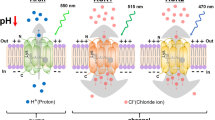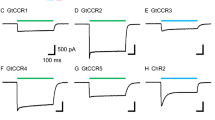Abstract
Phototaxis behavior is commonly observed in animals with light-sensing organs. C. elegans, however, is generally believed to lack phototaxis, as this animal lives in darkness (soil) and does not possess eyes. Here, we found that light stimuli elicited negative phototaxis in C. elegans and that this behavior is important for survival. We identified a group of ciliary sensory neurons as candidate photoreceptor cells for mediating phototaxis. Furthermore, we found that light excited photoreceptor cells by evoking a depolarizing conductance carried by cyclic guanosine monophosphate (cGMP)-sensitive cyclic nucleotide–gated (CNG) channels, revealing a conservation in phototransduction between worms and vertebrates. These results identify a new sensory modality in C. elegans and suggest that animals living in dark environments without light-sensing organs may not be presumed to be light insensitive. We propose that urbilaterians, the last common ancestor of bilaterians, might have already evolved a visual system that employs CNG channels and the second messenger cGMP for phototransduction.
This is a preview of subscription content, access via your institution
Access options
Subscribe to this journal
Receive 12 print issues and online access
$209.00 per year
only $17.42 per issue
Buy this article
- Purchase on Springer Link
- Instant access to full article PDF
Prices may be subject to local taxes which are calculated during checkout






Similar content being viewed by others
References
Kandel, E.R. The neurobiology of behavior. in Principles of Neural Science (eds. Kandel, E.R., Schwartz, J.H. & Jessell, T.M.) 5–66 (McGraw-Hill Medical, 2000).
Bargmann, C.I. Comparative chemosensation from receptors to ecology. Nature 444, 295–301 (2006).
Fu, Y. & Yau, K.W. Phototransduction in mouse rods and cones. Pflugers Arch. 454, 805–819 (2007).
Wang, T. & Montell, C. Phototransduction and retinal degeneration in Drosophila. Pflugers Arch. 454, 821–847 (2007).
Berson, D.M. Phototransduction in ganglion-cell photoreceptors. Pflugers Arch. 454, 849–855 (2007).
Kelber, A., Vorobyev, M. & Osorio, D. Animal color vision–behavioral tests and physiological concepts. Biol. Rev. Camb. Philos. Soc. 78, 81–118 (2003).
Bargmann, C.I. Chemosensation. in C. elegans. WormBook, 1–29〈http://www.wormbook.org/〉 (2006).
Bounoutas, A. & Chalfie, M. Touch sensitivity in Caenorhabditis elegans. Pflugers Arch. 454, 691–702 (2007).
Brenner, S. The genetics of Caenorhabditis elegans. Genetics 77, 71–94 (1974).
Burr, A.H. The photomovement of Caenorhabditis elegans, a nematode which lacks ocelli. Proof that the response is to light not radiant heating. Photochem. Photobiol. 41, 577–582 (1985).
Harris, W.A., Stark, W.S. & Walker, J.A. Genetic dissection of the photoreceptor system in the compound eye of Drosophila melanogaster. J. Physiol. (Lond.) 256, 415–439 (1976).
White, J.G., Southgate, E., Thomson, J.N. & Brenner, S. The structure of the nervous system of the nematode Caenorhabditis elegans. Phil. Trans. R. Soc. Lond. B 314, 1–340 (1986).
Gabel, C.V. et al. Neural circuits mediate electrosensory behavior in Caenorhabditis elegans. J. Neurosci. 27, 7586–7596 (2007).
Kaupp, U.B. & Seifert, R. Cyclic nucleotide–gated ion channels. Physiol. Rev. 82, 769–824 (2002).
Cho, S.W., Cho, J.H., Song, H.O. & Park, C.S. Identification and characterization of a putative cyclic nucleotide–gated channel, CNG-1, in C. elegans. Mol. Cells 19, 149–154 (2005).
Komatsu, H. et al. Functional reconstitution of a heteromeric cyclic nucleotide–gated channel of Caenorhabditis elegans in cultured cells. Brain Res. 821, 160–168 (1999).
Coburn, C.M. & Bargmann, C.I. A putative cyclic nucleotide–gated channel is required for sensory development and function in C. elegans. Neuron 17, 695–706 (1996).
Finn, J.T., Solessio, E.C. & Yau, K.W. A cGMP-gated cation channel in depolarizing photoreceptors of the lizard parietal eye. Nature 385, 815–819 (1997).
Stern, J.H., Kaupp, U.B. & MacLeish, P.R. Control of the light-regulated current in rod photoreceptors by cyclic GMP, calcium, and l–cis-diltiazem. Proc. Natl. Acad. Sci. USA 83, 1163–1167 (1986).
Yu, S., Avery, L., Baude, E. & Garbers, D.L. Guanylyl cyclase expression in specific sensory neurons: a new family of chemosensory receptors. Proc. Natl. Acad. Sci. USA 94, 3384–3387 (1997).
Mulsch, A., Luckhoff, A., Pohl, U., Busse, R. & Bassenge, E. LY 83583 (6-anilino-5,8-quinolinedione) blocks nitrovasodilator-induced cyclic GMP increases and inhibition of platelet activation. Naunyn Schmiedebergs Arch. Pharmacol. 340, 119–125 (1989).
Danziger, R.S. et al. Characterization of soluble guanylyl cyclase in transformed human nonpigmented epithelial cells. Biochem. Biophys. Res. Commun. 195, 958–962 (1993).
Bargmann, C.I., Hartwieg, E. & Horvitz, H.R. Odorant-selective genes and neurons mediate olfaction in C. elegans. Cell 74, 515–527 (1993).
Ward, S. Chemotaxis by the nematode Caenorhabditis elegans: identification of attractants and analysis of the response by use of mutants. Proc. Natl. Acad. Sci. USA 70, 817–821 (1973).
Gray, J.M. et al. Oxygen sensation and social feeding mediated by a C. elegans guanylate cyclase homologue. Nature 430, 317–322 (2004).
Chalfie, M. et al. The neural circuit for touch sensitivity in Caenorhabditis elegans. J. Neurosci. 5, 956–964 (1985).
Kaplan, J.M. & Horvitz, H.R. A dual mechanosensory and chemosensory neuron in Caenorhabditis elegans. Proc. Natl. Acad. Sci. USA 90, 2227–2231 (1993).
Cheung, B.H., Cohen, M., Rogers, C., Albayram, O. & de Bono, M. Experience-dependent modulation of C. elegans behavior by ambient oxygen. Curr. Biol. 15, 905–917 (2005).
Salvini-Plawen, L. & Mayr, E. On the evolution of photoreceptors and eyes. in Evolutionary Biology (eds. Hecht, M.K., Steere, W.C. & Wallace, B.) 207–273 (Plenum Press, New York, 1961).
Gehring, W.J. & Ikeo, K. Pax 6: mastering eye morphogenesis and eye evolution. Trends Genet. 15, 371–377 (1999).
Gehring, W.J. New perspectives on eye development and the evolution of eyes and photoreceptors. J. Hered. 96, 171–184 (2005).
Arendt, D., Tessmar, K., de Campos-Baptista, M.I., Dorresteijn, A. & Wittbrodt, J. Development of pigment-cup eyes in the polychaete Platynereis dumerilii and evolutionary conservation of larval eyes in Bilateria. Development 129, 1143–1154 (2002).
Chitwood, B.G. & Murphy, D.G. Observations on two marine monhysterids: their classification, cultivation, and behavior. Trans. Am. Microsc. Soc. 83, 311–329 (1964).
Croll, N.A. The phototactic response and spectral sensitivity of Chromadorina viridis (Nematoda, Chromadorida) with a note on the nature of the paired pigment spots. Nematologica 12, 610–614 (1966).
Montell, C. Visual transduction in Drosophila. Annu. Rev. Cell Dev. Biol. 15, 231–268 (1999).
Adoutte, A., Balavoine, G., Lartillot, N. & de Rosa, R. Animal evolution. The end of the intermediate taxa? Trends Genet. 15, 104–108 (1999).
Gray, J.M., Hill, J.J. & Bargmann, C.I. A circuit for navigation in Caenorhabditis elegans. Proc. Natl. Acad. Sci. USA 102, 3184–3191 (2005).
Li, W., Feng, Z., Sternberg, P.W. & Xu, X.Z.S.A. C. elegans stretch receptor neuron revealed by a mechanosensitive TRP channel homologue. Nature 440, 684–687 (2006).
Feng, Z. et al. A C. elegans model of nicotine-dependent behavior: regulation by TRP family channels. Cell 127, 621–633 (2006).
Bargmann, C.I. & Avery, L. Laser killing of cells in Caenorhabditis elegans. Methods Cell Biol. 48, 225–250 (1995).
Troemel, E.R., Chou, J.H., Dwyer, N.D., Colbert, H.A. & Bargmann, C.I. Divergent seven transmembrane receptors are candidate chemosensory receptors in C. elegans. Cell 83, 207–218 (1995).
Miranda-Vizuete, A. et al. Lifespan decrease in a Caenorhabditis elegans mutant lacking TRX-1, a thioredoxin expressed in ASJ sensory neurons. FEBS Lett. 580, 484–490 (2006).
Richmond, J.E. & Jorgensen, E.M. One GABA and two acetylcholine receptors function at the C. elegans neuromuscular junction. Nat. Neurosci. 2, 791–797 (1999).
Brockie, P.J., Mellem, J.E., Hills, T., Madsen, D.M. & Maricq, A.V. The C. elegans glutamate receptor subunit NMR-1 is required for slow NMDA-activated currents that regulate reversal frequency during locomotion. Neuron 31, 617–630 (2001).
Acknowledgements
We thank P. Hu and A. Kumar for comments; C. Bargmann for providing tax-2 rescuing strains; B. Decaluwe, M. Xia and S. Gu for technical assistance; L. Kang for movie editing; Q. Liu and Z.W. Wang for assistance in setting up recording; and members of the Xu lab for advice. Some strains were obtained from the Caenorhabditis Genetics Center. A.W. was supported by a US National Institutes of Health predoctoral training grant. This work was supported by the US National Institute of General Medical Sciences (NIGMS) and the Pew scholars program (X.Z.S.X.).
Author information
Authors and Affiliations
Contributions
A.W. conducted the experiments and analyzed the data in Figures 1, 2, 3, 4. J.L. conducted the experiments and analyzed the data in Figures 5 and 6. Z.F. developed tools to acquire and analyze behavioral data. X.Z.S.X. supervised the project and wrote the manuscript.
Corresponding author
Supplementary information
Supplementary Text and Figures
Supplementary Figures 1–6 (PDF 135 kb)
Supplementary Video 1
Head avoidance response. The movie is in AVI format. The animal was in forward motion at the beginning. At 5.80 s, a flash of light (2 s duration, A) was turned on. At 7.05 s, the animal paused and initiated backward movement that lasted for seven head swings, followed by an omega turn. The stage was moved manually during recording to keep the worm in the view field. (AVI 7499 kb)
Supplementary Video 2
Tail avoidance response. The movie is in AVI format. At 1.72 s, a flash of light (2 s duration, UV-A) was turned on. At 2.85 s, the worm responded by stopping backward movement and beginning to move forward. The stage was moved manually during recording to keep the worm in the view field. Light shed on the tail or body of a worm in forward motion would further stimulate its forward movement. (AVI 3851 kb)
Rights and permissions
About this article
Cite this article
Ward, A., Liu, J., Feng, Z. et al. Light-sensitive neurons and channels mediate phototaxis in C. elegans. Nat Neurosci 11, 916–922 (2008). https://doi.org/10.1038/nn.2155
Received:
Accepted:
Published:
Issue Date:
DOI: https://doi.org/10.1038/nn.2155
This article is cited by
-
A photoswitchable inhibitor of TREK channels controls pain in wild-type intact freely moving animals
Nature Communications (2023)
-
Photobehaviours guided by simple photoreceptor systems
Animal Cognition (2023)
-
Energy-guided synapse coupling between neurons under noise
Journal of Biological Physics (2023)
-
Brain-wide perception of the emotional valence of light is regulated by distinct hypothalamic neurons
Molecular Psychiatry (2022)
-
madd-4 plays a critical role in light against Bursaphelenchus xylophilus
Scientific Reports (2022)



